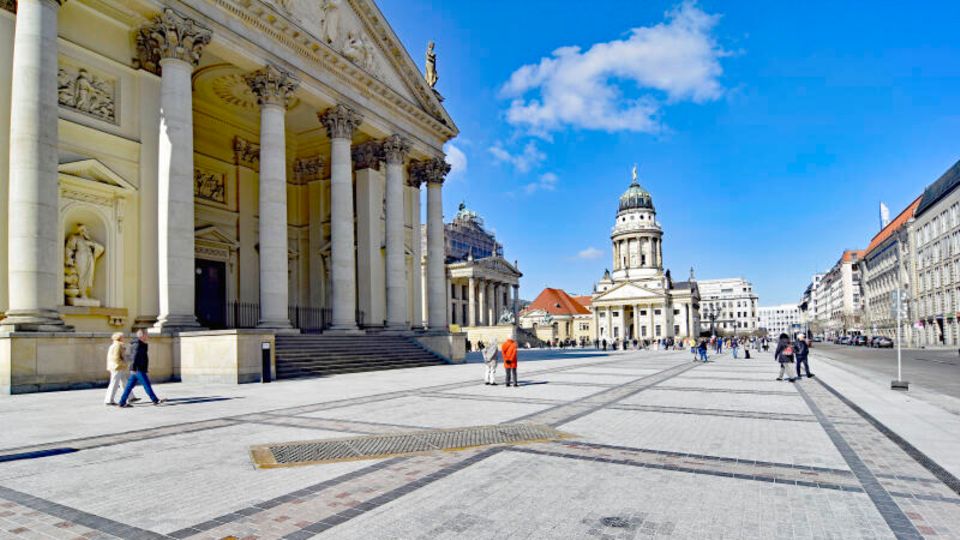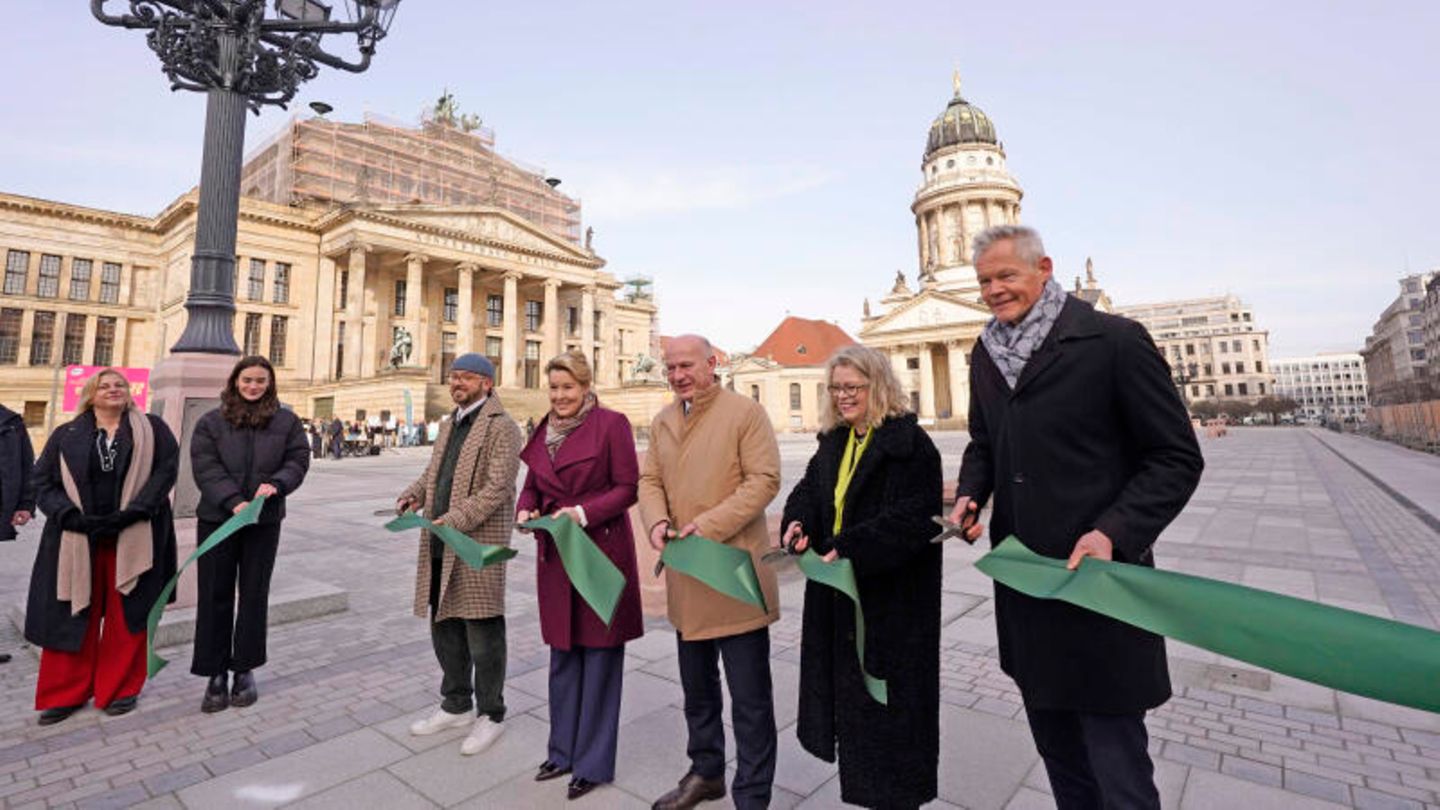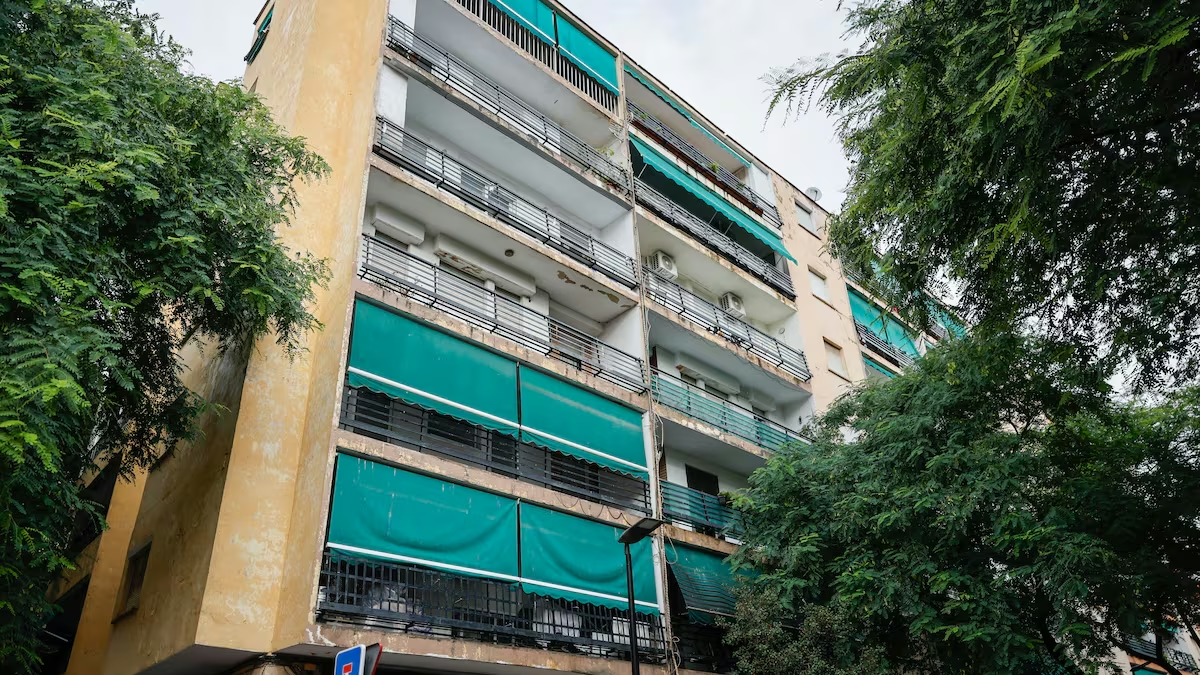Gendarmen market
21 million for a concrete desert – how could that happen?
Copy the current link
Add to the memorial list
The renovation of the Berlin Gendarmenmarkt ensures mockery: Is the once “most beautiful place in Berlin” a figurehead for the capital or only bleak?
In the current political climate, politicians from the CDU and the left would have thought that no one would have thought possible. And yet it “only” needed 21 million euros, two years of construction and a 14,000 square meter paved area. The reopening of the Gendarmenmarkt in Berlin-Mitte pushes a shake of the head across party borders.
So about the square between the concert hall, the German and the French cathedral: “It is neither to be understood from aesthetic, monument preservation nor for climate silants.” describes the newly renovated place on X as an “ugly concrete desert in the style of the 1970s”.
The place of a brick desert is like a place and will probably be not inviting in summer if the sun ranges relentlessly. But it is not quite as environmentally harmful as it seems at first glance. Under the pavement, six rainwater collecting pools were installed, which slowly let the water seep away and thus supply it to the groundwater. So far, the rainwater flowed directly into the sewage system and was lost.
The state -owned company Grün Berlin is responsible for the conversion. The renovation primarily relied on sustainable and energetic project goals. “Based on an extensive participation process, Grün Berlin made the gendarmen market fit for the future,” says the city planning office’s website.
21 million euros in concrete space
And yet the space looks almost the same as before – only with fewer trees. So how could there be a 21 million euro concrete area in Berlin-Mitte?
The process began in 2009 when the then Senate construction director Regula Lüscher wanted to restore the Gendarmenmarkt. The curbs should be removed to make the place barrier -free. The cable systems that are used for cafes and bars in summer and represented potential stumbling blocks should also disappear. And: the old patch was dilapidated and had to be renewed – but without destroying the historical identity of the square.

The raster pattern of the square played a central role. It was originally designed by the National Socialists when the Gendarmenmarkt was redesigned as a marching area on the occasion of the 1936 Olympic Games. After the war, this pattern was also integrated into the reconstruction of the concert hall and the two dome and is therefore part of the GDR cultural heritage.
“This legacy must be preserved”
A removal of the square, which would have been desirable from an environmental policy point of view, was therefore out of the question. “This inheritance must also be preserved,” said former cultural senator Klaus Lederer when the Senate Culture Administration 2021 the place design of the Gendarmenmarkt. “After all, the Gendarmenmarkt is the most important space room for postmodernity in the GDR.”
According to the association “Supporter and Friends of the Gendarmenmarkt eV”, the design of the square was quite successful. “The historical equipment such as Kandelaber, benches, bollards and lights was put into an optical-speaking state, which enables safe stroll again,” said the association in a press release.
However, there is criticism of the state of the northern square behind the French cathedral. There, the “popular and urgently needed, cooling, shade -giving” spherical corn trees – a fact that the association describes as “shocking and interpreting in Berlin”.
Berlin association had voted
It is thanks to the use of the association that there are still trees on the Gendarmenmarkt. “We collected 35,000 signatures to maintain the Gendarmenmarkt in the existing form 15 years ago,” said club chairman Frank Keidel the star. The Senate wanted to fell all the trees in the French cathedral to make the square completely barrier -free.
In 2010 there was a unique citizens’ forum in which Berliners were able to advise on the redesign of the square. Above all, it was about the 115 maple trees, which provided shade and a pleasant climate around the French cathedral. “The Berliners can decide on the future of the trees in the Citizens’ Forum”,
Japanese trees instead of home ball maple
In the vote, 596 of 876 participants spoke out for the preservation of the trees. But shortly after the vote, Senate construction director Lüscher made it clear that the administration would not adhere to this decision. “You cannot assume that a single tree will not be felled,” she told the “Berliner Zeitung” in 2011.
The top goal was accessibility – and some trees had to give way. The square had to be lowered to create accessibility. According to the website of the Green Berlin website, some of the trees could not be lowered because there is a subway tunnel below them.
Other trees were no longer healthy and therefore had to be felled. On the south side, three new Japanese cord trees were planted, which are considered particularly heat, dry and exhaust gas-resistant. In the future, they should ensure sufficient shade with an expansive crown of twelve to 18 meters.
Clubs Frank Keidel can understand that some trees had to be felled. However, it is incomprehensible that the Mitte district does not take care of the remaining trees. “21 million euros have been spent on the renovation,” says Keidel. In contrast, no money was invested in the care of the trees. Overgrown bushes, dried up hedges and threatening tree stumps are proof of the “lovelessness and disinterest” of the district.
The fact is: Even on social networks, the redesign ensures a lot of ridicule and criticism. There, many users see the renovation as another example of expensive, but ultimately missed major projects.
Source: Stern
I have been working in the news industry for over 6 years, first as a reporter and now as an editor. I have covered politics extensively, and my work has appeared in major newspapers and online news outlets around the world. In addition to my writing, I also contribute regularly to 24 Hours World.





